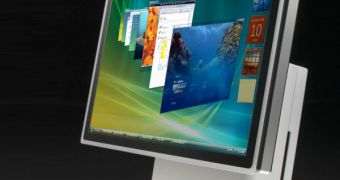With Windows 7, Microsoft could diverge from the now traditional monolithic blocks which are designed to deliver functionality, such as hardware management, support for application runtime, a disk file system etc. In this context, Windows 7 could be componentized in order to allow end users to build their own platforms. In order to understand the concept of a modular Windows 7 client, you have to think in terms of Windows Vista SKUs. Vista brings to the table no less than four editions that end users can install, benefiting from more features in the Ultimate edition compared to Business, Home Premium and Home Basic.
But what if users would be able to essentially select the components to be installed as Windows 7 and end up with their very own custom editions, for which they will be charged different license fees, even taking into consideration a subscription-based model. This is precisely the operating system described by a patent filed in 2006 by Microsoft under the title: "System and method for delivery of a modular operating system."
"An operating system and method for use include a core function module, or basic kernel, providing fundamental operating system support and one or more add-on modules that allow customization of the operating system as desired. Add-on modules may provide support or extended capability to the computer including hardware, applications, peripherals, and support. A digital signature may be used to confirm the integrity of an add-on module prior to installation. Certification may be verified to determine if installation of the add-on module is authorized. By withholding certification, a service provider may manage illegal or undesired modifications to a provided computer. Digital rights management may be used to enforce terms of use of the add-on module in keeping with licensing arrangements," it is revealed in the abstract of the patent.
Mary Jo Foley takes into consideration two ways in which Windows 7 could in fact be served in pieces. One involves the same level of modularization as Windows Server 2008. The latest Microsoft server platform comes as a set of roles which can be added to a minimal footprint installation. The same scenario could be transitioned and applied to Windows 7, especially since Microsoft has synchronized its Windows client and server operating systems. And the second possibility involves stripping default components from Windows 7, and making them available in the cloud via Windows Live Wave 3 suite of products and services. You can already witness such a move with solutions such as Windows Live Photo Gallery, Windows Live Messenger, etc.
At this point in time, the Redmond company has not offered any confirmation to support such a scenario. Windows 7 Milestone 1 delivered no indication of the next iteration of the Windows client becoming a modularized product. Still, Microsoft could deliver additional detail between November 5-7 in Los Angeles, at the Windows Hardware and Engineering Conference 2008.
"WinHEC is the key industry event for hardware engineers, system manufacturers, and driver developers who design and build easy-to-use, reliable PCs, servers, and devices that run and interface with Microsoft Windows operating systems. Now in its 17th year, this event brings industry professionals together to partner with Microsoft in driving future engineering and business directions for PC and device hardware," reads the description of the conference.

 14 DAY TRIAL //
14 DAY TRIAL //